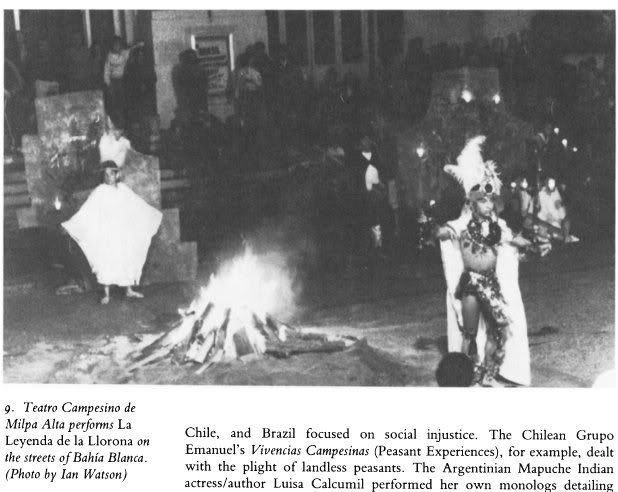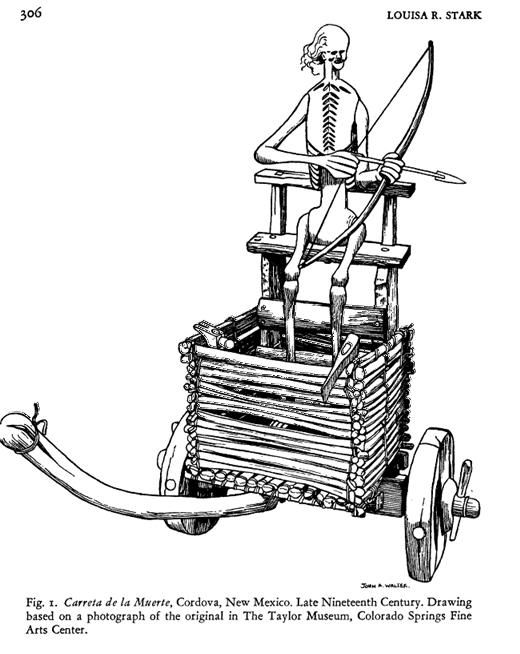Herron English 227
tiffanyherron
The Southwestern Hispanic folktales of early American time period, starting to notably permeate roughly around the early nineteenth century reveal much about the emerging culture and the impact they have made and still make today. Many of these stories are known for their paranormal and supernatural subject matter, the superstitions these stories engage the society in exemplify the many different interpretations one could make about the folk tales. In addition to the spiritual and ghostly subjects, the tales aim for different age groups, different hidden meanings of religion, relationships, sexuality, safety, and more. Four very important and classic tales are that of El Obispo, La Comadre Sebastiana, Los Tres Hermanos, and La Llorona.
|
One of the most well known tales is that of La Llorona. This image is from the Third Theatre in Latin America text by Ian Watson, showing street theatre performers depict a scene from the story of La Llorona. She is often described, particularly in the Chilean version, to dress in all white. There are quite a few different versions, but the one most told and recognized in the Hispanic Southwest is that of a woman's husband leaving her for another woman, then murdering her children and killing herself she is left as a spirit crying (llorando) from her sadness and looking for children and scaring people who come across her. |
|
The article here, La Llorona as a Social Symbol by Micheal Kearney, is significant in discussing these Hispanic folk tales. Analyzing the versions and lessons in La Leyenda de La Llorona, there are many social constructs revealed in the story. One of which is that of being faithful to one’s spouse, to preserve the sanctity of marriage, regardless of social class or other desires, if the version is that the couple was married together. Additionally, the dilemma began, in another very common version, when the Spaniard and La Llorona where together, and they had a child together, but they were not married. In both versions he had left her for another woman, and some form of unfaithfulness or abandonment occurred between the lovers. Kearney mentions her punishment is irreversible and I feel this emphasis of her ultimate state eternally being a spirit suffering and wandering is crucial to the lessons being emphasized in this story. Another lesson that permeates into society is that of a safety warning and protection for children. When told the story of La Llorona, one is not to be out alone at night and/or be susceptible to fear easily otherwise she would "get" the children. In her story, there are underlying messages of what not to be and how not to act, in order to not share her fate, but there are also superstitions and additions to each telling that warn people of what not to do to draw her near, which I believe is also an underlying message of how to, generally, be safe and have good company. |
|
La Comadre Sebastiana, or Doña Sebastiana, is known as a 'morality tale' and has strong religious themes throughout the entire story. The image depicts the Doña Sebastiana, who is death personified as a woman, and her crucial death cart. This image of the death cart is seen in many religious tales. The symbolism of the cart is significant in that it depicts, as in many Hispanic tales, not only eternal consequence but also suffering and penance. I believe that, with the story of Doña Sebastiana, social class is a strong subject that holds throughout the entire story, and one can make the connection between the low class drudgery of work and labor being connected to the actual image of being in the cart and/or pulling the cart, both which involve heavy suffering as the cart is Death's cart, told to be filled with the souls of those who have had tension with Death (or Doña Sebastiana) and ultimately who have struggled with religion. |
|
It is important to note the very strong religious subject in this story, and how this tale, along with other moral folk stories, where told by elders to young children in religious households. It is not entirely certain if these stories where popular to be spread inside the actual church, but members of the church still had the tales permeate through their household in conjunction with their religion. While seemingly superstitious and not a story "of the bible" they were still accepted. The story of La Comadre Sebastiana is not only teaching a lesson to have generally good morals, but to remember religious figures, religious morals and lessons, and tying in the consequences (sinning) to other religious figures in a very understandable way. In this story it involves particularly the concept of faith and trust versus doubt, priorities in addition to religious such as taking care of one’s family, and more importantly greed towards tangible or monetary things. The story of Comadre Sebastiana exemplifies this due to the discussion and resentment the woodcutter feels relating to his social class and the hypocrisy one would feel in that class towards religion and religious figures (for example, the Lord and the Virgin) and how his punishment and ending came from him beginning to feel doubt and greed. |
|
The story of The Three Brothers (Los Tres Hermanos) is another morality tale, with obvious and strong religious messages. The first two brothers were given religious guidance and messages from their parents, but they blatantly ignored and did not follow what they had originally been taught. They had gone against their religion and their parents. First, they where greedy, and I believe this is a common subject in these morality tales because a low social class and a lack of money, material objects, or even food, often caused resentment towards religion and the Church. In order to ensure people would stay, they were told to be grateful for what they had and have faith. Secondly, they did not respect their parents or family. The third brother continuously repeats to himself that he has the blessing of his parents, which creates a stronger tie to his faith and religion and priorities. Additionally I believe there is a further connection to that of the religious figure of the Father and ones father, and the Virgin mother and ones mother. This is important because these tales where primarily told to young children. |
|
The short tale of El Obispo, The New Bishop, is directed towards a larger audience, and I believe more towards those who already consider themselves religious but do not realize they might not be acting according to what they claim they are. The New Bishop was judgmental and rude, looking down on people who were glad to see him, respected him, and trying to greet him. When one man greeted him "correctly" he mentioned the others' Castillian was poor, and the people where apparently "backward and ignorant" because they did not greet him in the right manner. The message is that even though one can hold a place in the church, or even consider themselves to be good or correct religiously, one can still be sinning or acting inappropriately. The Bishop was judgmental and not thinking or acting like a religious figure. When the man pointed out his people are humble, and referred to the way the Bishop was originally and accidentally called a Saint or a Virgin, saying he is obviously neither, exemplifies how the Bishop was not behaving correctly. This shows he also sinned in another manner, as a Bishop is, according to the religion, supposed to be a virgin. I would consider the levels in the Church of sainthood, being a virgin, and being a Bishop in relation to this story. It is also important to note this is short and also humorous, intended as mentioned before, for children and youth. It does not necessarily involve youth or supernatural depictions of religious figures, but it still is told and reads quickly, with religion being the subject, and religious figures (The Bishop and The Virgin) that children know very well and the humor makes it memorable for youth. |
Ultimately the history of Hispanic story telling is rooted in many different things, such as religion, safety, marriage, family and children. The varieties of stories told depict the rich history of Hispanic and Latino traditions of storytelling and folk tales, particularly the ones discussed here regarding the Southwest exemplify the unique culture that blossomed in the early nineteenth century.






![The Girlhood of Mary Virgin [print]](http://www.rossettiarchive.org/img/sa680.hollyer.jpg)